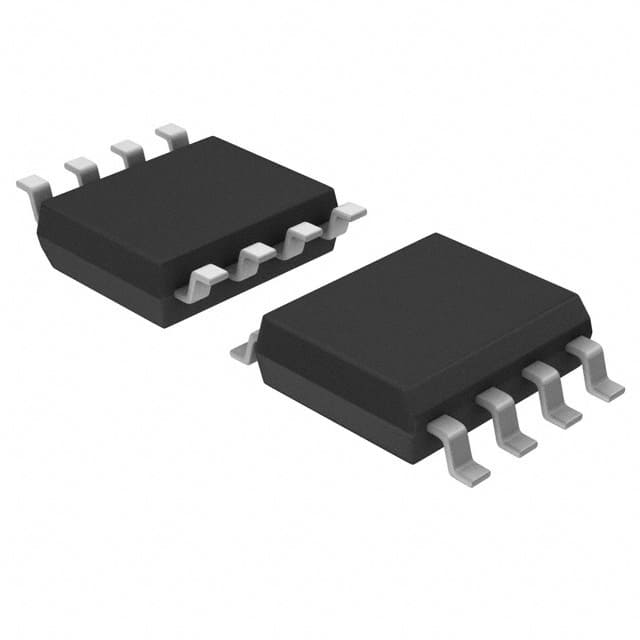Viz Specifikace pro podrobnosti o produktu.

S-24C16DI-J8T1U5
Basic Information Overview
- Category: Integrated Circuit (IC)
- Use: Data storage and retrieval
- Characteristics: Non-volatile, serial EEPROM (Electrically Erasable Programmable Read-Only Memory)
- Package: SOP-8 (Small Outline Package)
- Essence: High-density memory chip for storing digital data
- Packaging/Quantity: Tape and reel packaging, 2500 units per reel
Specifications
- Memory Capacity: 16 kilobits (2 kilobytes)
- Interface: I2C (Inter-Integrated Circuit) bus protocol
- Operating Voltage: 1.7V to 5.5V
- Operating Temperature Range: -40°C to +85°C
- Write Cycle Endurance: 1 million cycles
- Data Retention: 100 years
Detailed Pin Configuration
The S-24C16DI-J8T1U5 IC has a total of 8 pins arranged as follows:
```
| | | U1 | |___________|
Pin Configuration:
1 2 3 4
___________
| |
8 | | 5 | | ‾‾‾‾‾‾‾‾‾‾‾ 7 6 ```
Pin Description: 1. A0: Address Input 0 2. A1: Address Input 1 3. A2: Address Input 2 4. VSS: Ground 5. SDA: Serial Data Input/Output 6. SCL: Serial Clock Input 7. WP: Write Protect 8. VCC: Power Supply
Functional Features
- Non-volatile memory: The S-24C16DI-J8T1U5 retains data even when power is removed.
- Serial communication: It uses the I2C bus protocol for easy interfacing with microcontrollers.
- High-density storage: With a capacity of 16 kilobits, it can store a significant amount of digital data.
- Low power consumption: It operates at low voltage and has a standby current of only a few microamps.
Advantages and Disadvantages
Advantages: - Compact size and lightweight due to SOP-8 packaging - Easy integration with existing I2C-based systems - High endurance and long data retention period - Low power consumption ideal for battery-powered devices
Disadvantages: - Limited storage capacity compared to larger EEPROMs - Requires an external pull-up resistor for proper I2C communication
Working Principles
The S-24C16DI-J8T1U5 utilizes EEPROM technology to store and retrieve digital data. It employs a floating gate transistor structure that allows for non-volatile data storage. When data needs to be written, an electric charge is applied to the floating gate, altering its electrical characteristics. This change in charge determines the stored data. Reading the data involves sensing the electrical state of the floating gate.
Detailed Application Field Plans
The S-24C16DI-J8T1U5 IC finds applications in various fields, including: 1. Consumer Electronics: Used in smart TVs, set-top boxes, and audio/video equipment for storing configuration settings and user preferences. 2. Automotive: Employed in automotive electronics for storing critical data like mileage, vehicle settings, and diagnostic information. 3. Industrial Automation: Integrated into industrial control systems for storing calibration data, production parameters, and device configurations. 4. Medical Devices: Utilized in medical equipment for storing patient data, device settings, and firmware updates.
Detailed and Complete Alternative Models
- S-24C08DI-J8T1U5: 8 kilobit (1 kilobyte) capacity, same package and interface.
- S-24C32DI-J8T1U5: 32 kilobit (4 kilobytes) capacity, same package and interface.
- S-24C64DI-J8T1U5: 64 kilobit (8 kilobytes) capacity, same package and interface.
These alternative models offer different memory capacities while maintaining compatibility with the SOP-8 package and I2C interface.
Word count: 526 words
Seznam 10 běžných otázek a odpovědí souvisejících s aplikací S-24C16DI-J8T1U5 v technických řešeních
Sure! Here are 10 common questions and answers related to the application of S-24C16DI-J8T1U5 in technical solutions:
Q1: What is S-24C16DI-J8T1U5? A1: S-24C16DI-J8T1U5 is a specific model of an I2C-compatible EEPROM (Electrically Erasable Programmable Read-Only Memory) chip.
Q2: What is the capacity of S-24C16DI-J8T1U5? A2: S-24C16DI-J8T1U5 has a capacity of 16 kilobits, which is equivalent to 2 kilobytes.
Q3: What is the operating voltage range for S-24C16DI-J8T1U5? A3: The operating voltage range for S-24C16DI-J8T1U5 is typically between 1.7V and 5.5V.
Q4: How can S-24C16DI-J8T1U5 be interfaced with a microcontroller? A4: S-24C16DI-J8T1U5 uses the I2C protocol for communication, so it can be easily interfaced with a microcontroller using the I2C bus.
Q5: Can S-24C16DI-J8T1U5 be used for storing program code? A5: No, S-24C16DI-J8T1U5 is primarily designed for storing small amounts of non-volatile data, such as configuration settings or calibration data.
Q6: What is the maximum frequency at which S-24C16DI-J8T1U5 can operate? A6: S-24C16DI-J8T1U5 can operate at a maximum frequency of 400 kHz.
Q7: Is S-24C16DI-J8T1U5 capable of performing write operations? A7: Yes, S-24C16DI-J8T1U5 supports both read and write operations, allowing data to be written to specific memory locations.
Q8: Can S-24C16DI-J8T1U5 retain data during power loss? A8: Yes, S-24C16DI-J8T1U5 is non-volatile, meaning it can retain data even when the power supply is disconnected.
Q9: What is the typical endurance of S-24C16DI-J8T1U5? A9: S-24C16DI-J8T1U5 has a typical endurance of 1 million write cycles per memory location.
Q10: Does S-24C16DI-J8T1U5 have any built-in security features? A10: No, S-24C16DI-J8T1U5 does not have any built-in security features. It is a standard EEPROM chip without encryption or protection mechanisms.
Please note that these answers are general and may vary depending on the specific datasheet and manufacturer's specifications for S-24C16DI-J8T1U5.

